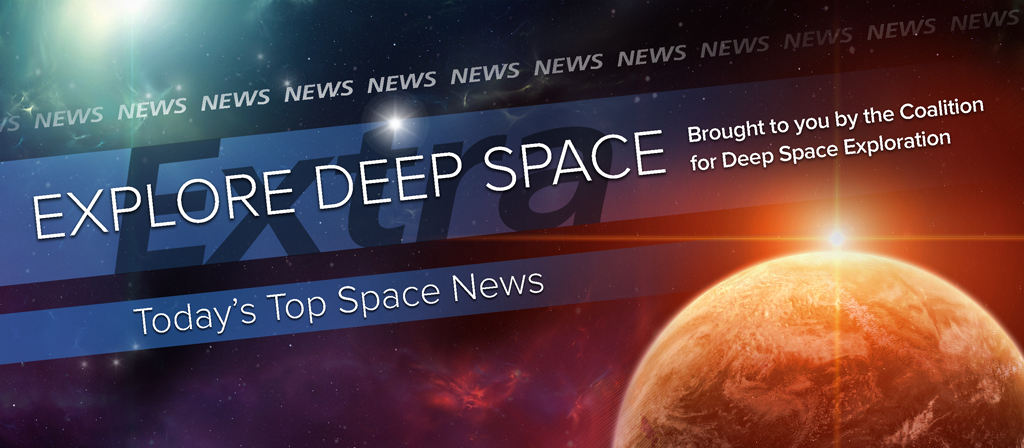Today’s Deep Space Extra offers the latest reporting and commentary on space related activity from across the globe. Will humans explore beyond Mars? NASA’s advanced exploration division marks progress with the development of a habitat for deep space travel. Todd May is named acting director of NASA’s Marshall Space Flight Center. U.S. Air and Space Museum seeks volunteers to compile lists of equipment launched to the moon during Apollo missions. NASA ponders uncrewed missions for the Space Launch System exploration rocket. Curiosity Mars rover finds more mineral evidence for past water. Computer modeling addresses lunar volatile mystery. China readies dark matter observatory for mid-December launching. Mysterious orbital debris re-enters Earth’s atmosphere early Friday. The International Space Station has avoided orbital debris four times so far this year. Orbital ATK prepares for a Dec. 3 cargo mission launch to the International Space Station. United Launch Alliance receives a U.S. Air Force contract for National Reconnaissance Office missions. A look at major space related activities planned for the week ahead.
Human Deep Space Exploration
Oh the places we won’t go: Humans will settle Mars, and nowhere else [excerpt]
Scientific American (11/13): Humanity is capable of reaching Mars in its explorations of space, writes Louis Friedman, co-founder of the Planetary Society, in a new book. But humans will turn to technologies like nanotechnology robotics, bio molecular engineering and artificial intelligence to pursue destinations at vast distances beyond.
NASA reviews progress of habitat development for deep-space exploration
NASAspaceflight.com (11/13): NASA’s Human Exploration and Operations Mission Directorate Advanced Exploration Systems division marks progress in the early development of a habitat for astronauts assigned to future deep space missions launched with the Space Launch System exploration rocket and Orion crew capsule. The envisioned habitat module would help to make it possible for a crew of four to reach Mars over 1,100 days.
NASA center in Huntsville names acting director
Huntsville Times (11/14): Todd May was named acting director of the Marshall Space Flight Center on Friday. He steps in for retiring director Patrick Scheuermann. May, Marshall’s deputy director since August, served previously as manager of Space Launch System exploration rocket development for NASA at Marshall.
Smithsonian seeking space fans to retype Apollo spacecraft packing lists
Collectspace.com (11/12): The Smithsonian Institution and U.S. Air and Space Museum are seeking volunteers to help compile a list of the equipment launched to the moon aboard NASA’s Apollo spacecraft. “With the help of volunteers, these transcriptions will eventually lead to a reliable and searchable database,” says Allan Needell, a curator with the Air and Space Museum’s space history department.
Unmanned Deep Space Exploration
SLS rocket could help scientists answer big questions
Aviation Week & Space Technology (11/16): NASA ponders missions for the Space Launch System exploration rocket beyond human deep space exploration, including the uncrewed launches of powerful space telescopes that could analyze the atmospheres of exo-planets for bio-signatures and big picture planetary missions.
Mars Rover finds rich mineral stew in fractured rock
Discovery News (11/15): Working at the base of Mount Sharp, NASA’s Mars Curiosity Rover has identified veins of calcium sulphate in the rock formations, evidence of repeated appearances of liquid water. Curiosity used an instrument called the ChemCam laser to make the identification. The findings were presented before the American Astronomical Society planetary science meeting last week.
Two-stage process formed moon, simulations suggest
Science News (11/13): The moon may have formed over a two stage process that started with a collision involving the early Earth and another planet sized object. According to computer simulations, volatiles not found on the moon’s surface today were gathered up by the Earth. Some volatiles are likely buried below the lunar surface. Samples of the moon gathered by astronauts on NASA’s Apollo 15 and 17 missions are supportive of the process.
Low Earth Orbit
China to launch Dark Matter Satellite in mid-December
Xinhuanet (11/14): The Chinese Academy of Sciences has set mid-December for the launching of the Dark Matter Particle Explorer Satellite for observations of the direction, energy and electric charge of high-energy particles in space.
Researchers rendezvous with falling space debris
Nature (11/13): A large piece of space debris from a mysterious source re-entered the Earth’s atmosphere harmlessly early Friday. Labeled WT1190F, the fragment crashed into the ocean off the southern coast of Sri Lanka without causing harm.
ISS dodged space junk four times in nine months – NASA
Interfax, of Russia (11/13): The four objects avoided by the six person International Space Station with Russian rocket engines included fragments of old U.S. and Chinese satellites and rocket bodies.
Commercial to Low Earth Orbit
Upgraded Cygnus spacecraft stacked and ready to conduct OA-4 mission
Spaceflight Insider (11/14): Orbital ATK and NASA are looking to Dec. 3 for the next U.S. commercial re-supply mission launch to the International Space Station. The flight with 7,745 pounds of cargo will mark the first for Orbital since it lost its third contracted mission in a launch explosion Oct. on 28, 2014.
USAF awards ULA $373M contract modification for rocket production services
GovConWire.com (11/13): The U.S. Air Force has contracted with United Launch Alliance for $373.3 million to prepare a Delta 4 and Atlas 5 launch vehicles for future National Reconnaissance Office missions.
Major Space Related Activities for the Week
Major space related activities for the week of November 16-20, 2015
Spacepolicyonline.com (11/14): The U.S. House could take up compromise commercial space legislation this week. Houston hosts the Space Commerce Conference.

